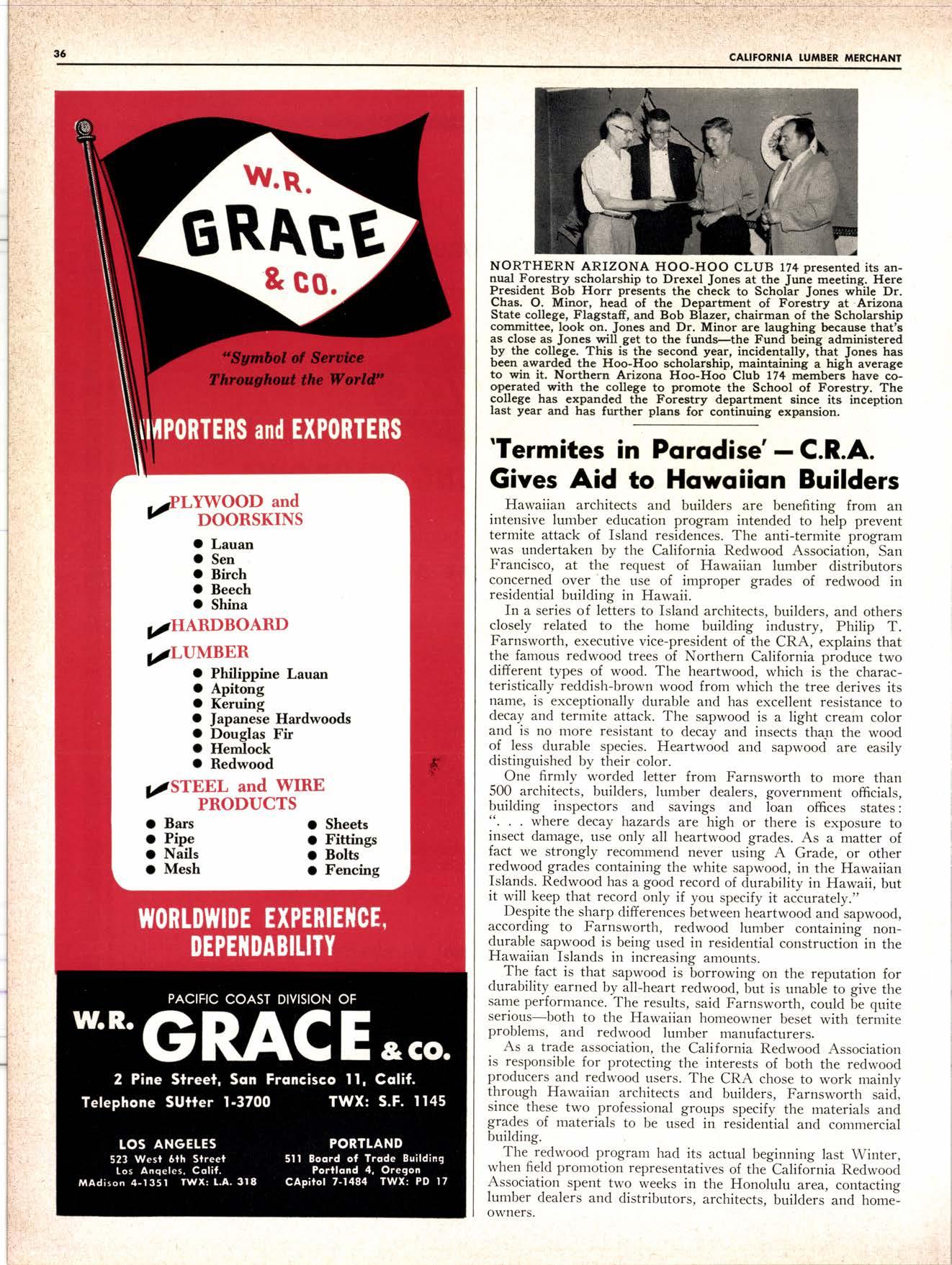
2 minute read
gRAEE
NORTHERN ARIZONA HOO-HOO CLUB 174 presented its annual Forestry scholarship to Drexel Jones at the June meeting. Here P_residelrt B6b Horr preiscnts the chick to Schol--ar Jones wh--ile Dr. Chas. O. Minor, head of the Departncnt of Forestry at Arizona State college, Flagstaff, and Bob Blazer, chairman of the Scholarship cornfirittce, look on. Jones and Dr. Minor are laughing becausc that's as close as Jones will get to the fiurds-the Fund being administered by the collcgc. This is the second year, incidentally, that Jones has bcen awarded the Hoo-Hoo scholarship, maintaining a high averagc to win it. Northern Arizona Hoo-Hoo-'Club 174 nrErnberl have 6 opgrated with the college to promote the School of Forestry. The college has cxpanded the Forestry department since its inception last year and has further plans foi continuing expa.nsion,
'Termites in PorodisG'- C.R.A. Gives Aid to Hqwqiiqn Builders
Hawaiian architects and builders are benefiting from an intensive lumber education program intended to help prevent termite attack of Island residences. The anti-termite piogram was undertaken by the California Redwood Associatibn, San Francisco, at the request of Hawaiian lumber distributors concerned over'the uie of improper grades of redwood in residential building in Hawaii.
In a series of letters to Island architects. builders. and others closely related to the home building industry, Philip T. Farnsworth, executive vice-president of the CRA, explains that the famous redwood trees of Northern California prbduce two different types of wood. The heartwood, which is the characteristically reddish-brown wood from which the tree derives its name, is exceptionally durable and has excellent resistance to decay and termite attack. The sapwood is a light cream color and is no more resistant to decav and insects than the wood of less -durable species. Heartw6od and sapwood' are easily distinguished by their color.
One firmly worded letter from Farnsworth to more than 500 architects, builders, lumber dealers, government officials, building inspectors and savings and loan ofifrces states: ". where decay hazards are high or there is exposure to insect damage, use only all heartwood grades. As a hatter of fact we strongly recommend never using A Grade, or other redwood_grades containing the white sapwood, in the Hawaiian Islands. Redwood has a good record of durability in Hawaii, but it will keep that record only if you specify it ac-curately.,'
Despiteihe sharp differences 6etwein heartwood and'sapwood, according to Farnsworth, redwood lumber containing non4urable sapwood is being used in residential construction- in the Hawaiian Islands in inireasing amounts.
The.fact is that sapwood is -borrowing on the reputation for durability- earned by all-heart redwood, biut is unabli to give the same performance. The results, said Farnsworth, could 6e quite serious-both to the Hawaiian homeowner beset with termite problems, and redwood lumber manufacturers.
As a trade association, the California Redwood Association is responsible for protecting the interests of both the redwood producers and redwood users. The CRA chose to work mainlv through Hawaiian architects and builders. Farnsworth said, since these two professional groups specify the materials and grades of materials to be used in res-ideniial and commercial building.
.The^redwood program had its actual beginning last Winter, when field promotion representatives of the California Redwood Association spent tw_o weeks in the Honolulu area, contacting lumber dealers and distributors, architects, builders'and homel owners.










